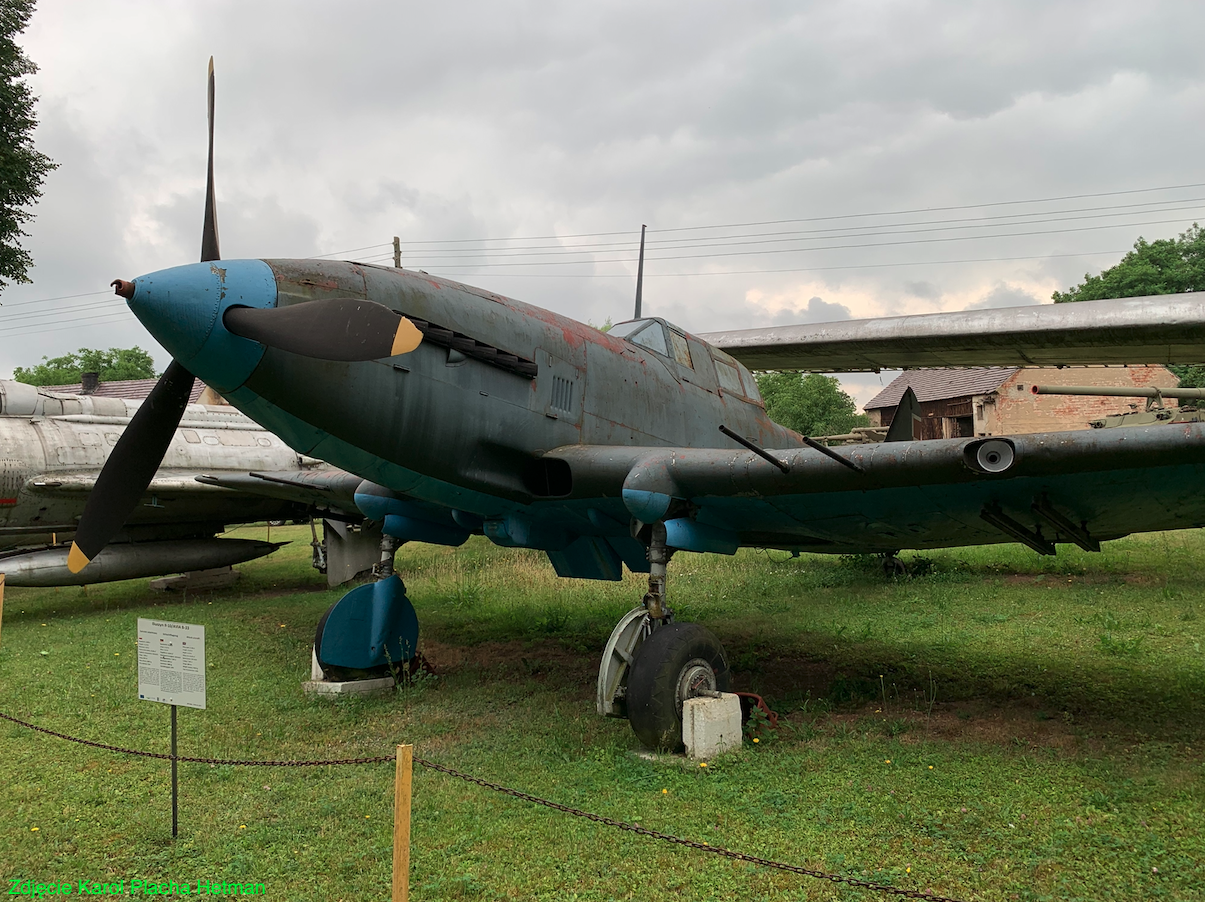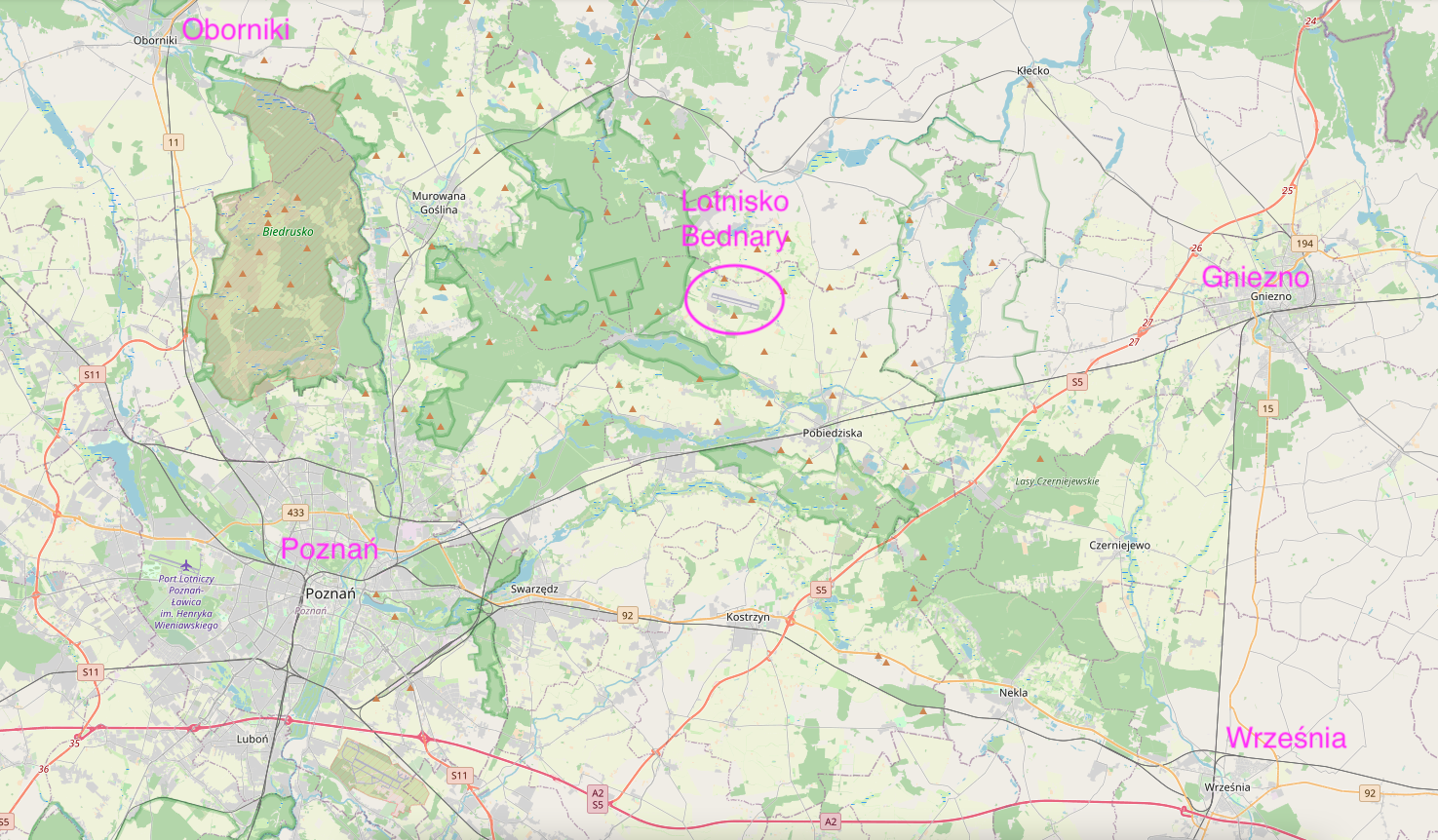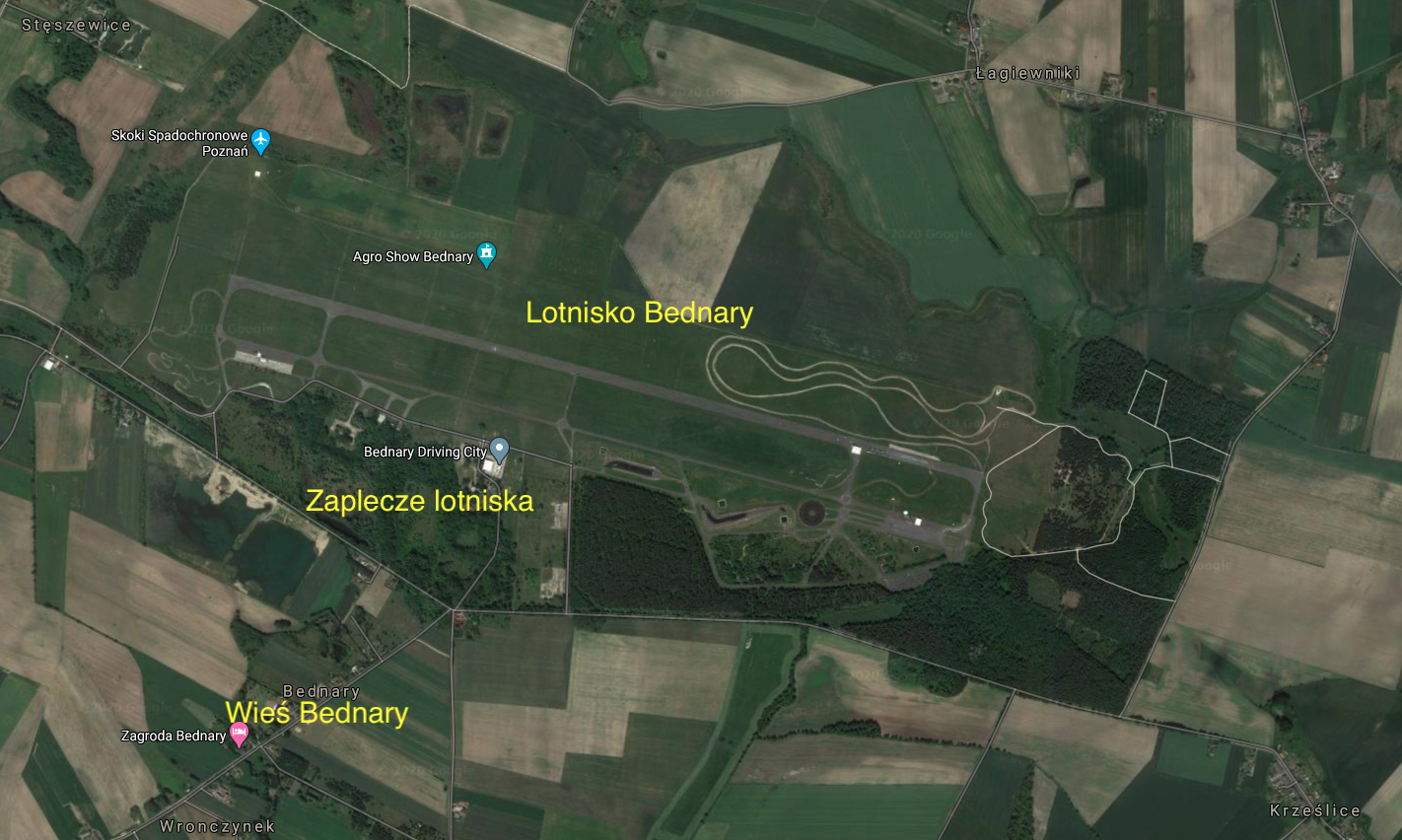Poznań 2009-09-14
Bednary Wielkopolskie Airport near Poznań.
Geographic coordinates: 52.534N 17.217E.



Bednary airport.
The airport is located in the small town of Bednary, in the Pobiedziska Commune, Wielkopolska Province. Despite the short distance from Poznań (about 30 km), access to it is difficult. Bednary is not located on any important trade route. There are also no railways there. Access only by municipal roads. Bednary Airport is located on the edge of the Zielonka Forest, which since 1993 has been called the Zielonka Forest Landscape Park, and it has an area of over 11,000 hectares.
For almost 50 years, the airport served as a military backup airport. Since about 2000, it has been used civilly; by aviators, model makers, car and motorcycle drivers, farmers, scouts and others. It is in private hands and managed by the Poznań Aeroclub.
History of Bednary Airport.
In September 1939, when the German army invaded the Republic of Poland, the whole of Wielkopolska was incorporated into the German empire. In 1940, the German authorities started building several new airports. One of them was the airport located only 25 km (as the crow flies) from Poznań, in the north-eastern direction, on the eastern edge of the forest. It is also about 25 km to Gniezno.
The airport received a grass runway. Several wooden buildings were built; pilot's house, workshops, warehouse, canteen. The planes were centered in the forest.
From August 1941 to January 1942, a German training squadron operating Bf-109E aircraft was stationed at Bednary Airport. Then, from the beginning of 1944 to September 1944, a German bomber and reconnaissance squadron was stationed in Bednary.
After World War II, Wielkopolska again found itself within the borders of Poland. After the war, some aircraft wrecks and other equipment remained, which can still be found in the surrounding forests to this day.
Due to the Korean War and the imperialist policy of the CCCP, a new plan for the expansion of aviation was created. New aviation units were created and airports were expanded. In the period from May 1, 1952 to December 1, 1952, the 53rd Air Assault Regiment was formed at the Bednary airport, armed with Iliuszyn Il-10 aircraft. The regiment was formed on the basis of a squadron from the 6th PLSz. The regiment was subordinated to the 16th Assault Aviation Division with its headquarters in Piła. The regiment was then moved to Mirosławiec, to a newly modernized airfield. This 53rd PLSz was the only regiment stationed in Bednary. All successively arriving regiments for a short time treated this airfield as a spare one. Full airport facilities have never been developed in Bednary, not to mention social and living facilities.
At the turn of the 50s and 60s, the airport received a new concrete DS (RWY), capable of receiving turbojet aircraft. Its dimensions are 1,500 m x 30 m. Concrete decks and stands for aircraft have been built in a centered layout.
The Bednary airport was used as a spare by various Regiments. One of them in the 60s was the 6th PLM-Sz from Piła. On August 8, 1968, the Lim-6 bis plane crashed in Bednary. Two machines of this class took off from the grass DS (RWY). One of them crashed, burying the commander of the flight in the remains.
At the beginning of the 1970s, another expansion of the airport infrastructure took place. RWY has been extended from 1,500 m to 2,300 m by adding a section of about 400 m on both sides. The width of the RWY has not changed, 30 m. Two new PPS, western and eastern, have been built. Both with dimensions of 200 m x 60 m. Centered aircraft stands (10 copies) received earth embankments on three sides with a height of about 4 m. This condition of the airport has been practically preserved to this day.
From the turn of the 60s and 70s, the Bednary airport became a backup airport for the Regiment from Powidz. Since 1974, Sukhoi Su-20 planes have been systematically landing here. On May 22, 1978, near Bednar, the town of Pawłowo Kolonia, during a night flight on a reconnaissance in NZWA, Su-20 No. 74313 nb 6263 crashed into the ground, burying the pilot lieutenant engineer Antoni Dziadowiec in his remains.
From 1984, Sukhoi Su-22 aircraft began to operate from Bednary Airport.
Socio-economic changes in Poland after 1989 resulted in a decrease in the intensity of training on combat aircraft. As a result, military planes flew to Bednar less frequently. The military handed over the facility to the AMW (Military Property Agency). The Poznań Aeroclub became the new manager of the airport. A new period of civil operation has begun for the airport.
Due to the short distance of the airport from Poznań, and at the same time non-urbanized surroundings, located near forests and lakes, Bednary has become a great place for summer recreation and making dreams of flying come true. This activity was developed by the Aeroclub of the Republic through the Aeroclub of Poznań. Gliders, parachutists, motor hang gliders and pilots of ultralight aircraft are trained here. From gliders, you can meet storks, eagle owls and other native production here. Generally, glider launches take place with a winch, which is much cheaper. Every year various gliding competitions are held here.
In 2004, the Poznań Aeroclub built the first hangar for gliders at the airport. On July 11, 2004, the official opening of the hangar was held, accompanied by a Holy Mass and the dedication of the new facility. Father Tomasz Sielicki was the celebrant.
Around 2010, the Poznań Aeroclub withdrew from the Bednary airport and moved to the Poznań Kobylnica airport and the Kąkolewo airport.
At the airport, modellers have also had their paradise here for years. Many national and international events are held here. E.g.; On May 16-17, 2009, a modeling picnic was held, the 2nd National Rally of Giants 2009 - self-propelled RC models with a wingspan of not less than 2 meters. The picnic was attended by Marek Szufa on his Curtiss Jenny and Super Skybolt 300.
For 90 years, the airport has been the summer air base of the State Forests, the purpose of which is fire protection. In the 1990s, PZL Dromader firefighting planes were stationed in Bednary, but they were moved to the airport in Michałków near Ostrów Wielkopolski. In the first decade of the 21st century, the tasks of forest observation were taken over by the Heliseco Aviation Service Company, which performs flights for the State Forests for 5 months a year, forming the staff of the Forest Air Base. They perform patrol flights for the Regional Directorate of State Forests and cover almost the entire area of Wielkopolska.
Lotnicze Przedsiębiorstwo Usługowe Heliseco SP. Z O.O. The company was established in 1975 as a separate unit under the name ZEUŚ (Zakład Eksploatacyjny Usług Migłowcowych), within the organizational structure of WSK "PZL Świdnik". The tasks of ZEUŚ included the implementation of civil helicopter services, in particular agricultural aviation services, the transport of travelers, the transport of cargo and the implementation of research programs on application apparatus mounted on helicopters and training of aviation personnel. Having support in the parent plant - the manufacturer of MI-2 and KANIA and PZL W-3 SOKÓŁ helicopters and their equipment, the company developed dynamically.
Since 1975, the company has provided a wide range of air services in Poland, Egypt, Sudan, Spain, Portugal and many other countries. From the beginning of its existence, LPU Heliseco Sp. z o. o. performed over 166,000 hours of service flights.
In 1992, the company "ZEUS" was transformed into a company named Lotnicze Przedsiębiorstwo Usługowe Heliseco Sp. z o. o. The 100% stake in the company was owned by WSK PZL Świdnik S.A. The vast experience gained by pilots and mechanics over 25 years of work in various conditions was a guarantee of safe and reliable performance of aviation tasks. The extensive experience of the flight crews is evidenced by the fact that the average flight time of helicopter commanders ranges from 3,000 to 12,000 hours. The scope of the offer in the area of civil helicopter services included the following types of flights: forest fire protection, protection of agricultural and forest crops against pests and diseases, control of power lines from the air, transport of passengers and cargo, service of sports and tourist events, training of aviation personnel, crane and assembly, advertising and photogrammetric flights. In the new century, Spanish capital joined the company. The company was poorly managed and ceased to function in 2015.
Airport in non-aviation activity.
But Bednary is also an activity not related to aviation. At the Bednary Airport, in August 2000, the town of the World Rally of Polish Scouting GNIEZNO 2000 was located - organized by the Polish Scouting Association with the participation of almost 10,000 scouts. The scouts were visited by the President of the Republic of Poland Aleksander Kwaśniewski himself.
Since Wielkopolska is famous for its high agricultural culture, which is higher than agriculture in Western Europe, it is not surprising that since 2003, every year at the airport, the AGRO SHOW, i.e. the International Agricultural Exhibition organized by the Polish Chamber of Commerce for Agricultural Machines and Facilities, has been held. It is the largest exhibition of agricultural machinery in Poland and one of the largest in Europe. During the exhibition, you can see agricultural machinery from the largest global, European and Polish manufacturers. You can see on it; agricultural tractors, combine harvesters, plows, seed drills, fertilizer spreaders, agricultural trailers, cultivating aggregates, sprayers and many others. Thanks to AGRO SHOW, Bednary is recognized by the rest of Poland.
A significant percentage of former wax airports are the arena of more or less legal car, motorcycle, go-kart and other races. Bednary Airport excels in these events. Most of the events are here. They are perfectly organized and attract the largest number of participants and spectators. In 2006, MOTOR EXTREME SHOW Bednary was held here - this competition in Bednary is, after Bemowo, the second event of great importance in Polish street freestyle. Competitors from Poland, France, Russia and Latvia taking part in the competition could present their excellent skills in front of the gathered spectators. For several years, the driving school of Mr. Sobiesław Zasad, the most famous rally driver in Poland, prospered here.
Bednary airport. 2009.
Bednary Airport is entered in the register of civil landing sites under number 48, with the code EPPB (Europa Polska Pobiedziska Bednary) adapted for take-offs and landings of aircraft with a maximum take-off weight (MTOW) of up to 5,700 kg, intended for helicopter and airplane flights with a maximum weight takeoff weight (MTOW) of 5,700 kg and for glider flights, motor glider flights, balloon flights, microlight flights, paragliding flights and parachute jumps. The airstrip is adapted to perform VFR flights during the day and at night. The helipad is active only when day or night starting signs are set up. Arrivals should be agreed with the manager at least 24 hours before the planned operation.
Geographical coordinates are; 52 degrees 32 minutes latitude N, 17 degrees 13 minutes long E. It lies 115 m above sea level. The operator of the airport is Aeroklub Poznański 62-006 Kobylnica Airport tel.: +48 (61) 8780725. Airport code EPPB. Airport call sign - Bednary KWADRAT EPPB. Frequency 122.900 MHz.
RWY in the geographical direction 10/28, exactly 105 degrees and 285 degrees. Asphalt pavement. Legalized dimensions; for VFR flights during the day 1 900 m x 30 m (the 400-meter eastern section is exclusive), at night 900 m x 30 m. grassy parallel to the asphalt road on the north side. It has dimensions of 1,900 m x 135 m.
The actual dimensions of the DS (RWY) are 2,300 m x 30 m and the area is 69,000 square meters. It has typical dimensions used at alternate airports. It was made of concrete, and over time covered with an asphalt surface.
There are approximately 6,000 m of taxiways at the airport, varying in width from 10 m to 15 m, and an area of approximately 72,000 m2. Made with the same technology as DS (RWY). Initially, the airport had 12 individual aircraft stands located along the main lane and another 10 stands located in the eastern part of the airport. As I mentioned above, over time, the centered positions were given earth embankments and two PPSs were built; eastern and western. Internal roads for cars are also paved and usually with an asphalt surface. There are about 20 buildings at the airport, which had different purposes during the army's presence. The buildings were mainly made of bricks. Their volume was about 10,000 cubic meters, and the usable area was about 3,000 square meters. The fuel depot had tanks with a total capacity of about 500 cubic meters.
Bednary airport. 2020.
Since 2010, the airport has been renamed an airstrip. The helipad is owned by the Test & Training Safety Center and Sobiesław Zasada Centrum Sp. z o. o. Bednary 17, 62-010 Pobiedziska. Coordinates of the landing site 52° 32' 05" N, 17° 12' 57" E. Airport frequency: 122.900 MHz - Bednary Radio.
RWY: (DS 1) 1900 x 30 m (105°R/285°L), concrete, night 900 x 135 m. (DS 2) 1900 x 135 m (105°L/285°R), grass, night 900 × 50 m. Runway elevation: 113 m / 370 ft (a.s.l.). Allowed air traffic: VFR day and night. Arrivals must be agreed with the Manager at least 24 hours in advance.
Written by Karol Placha Hetman
